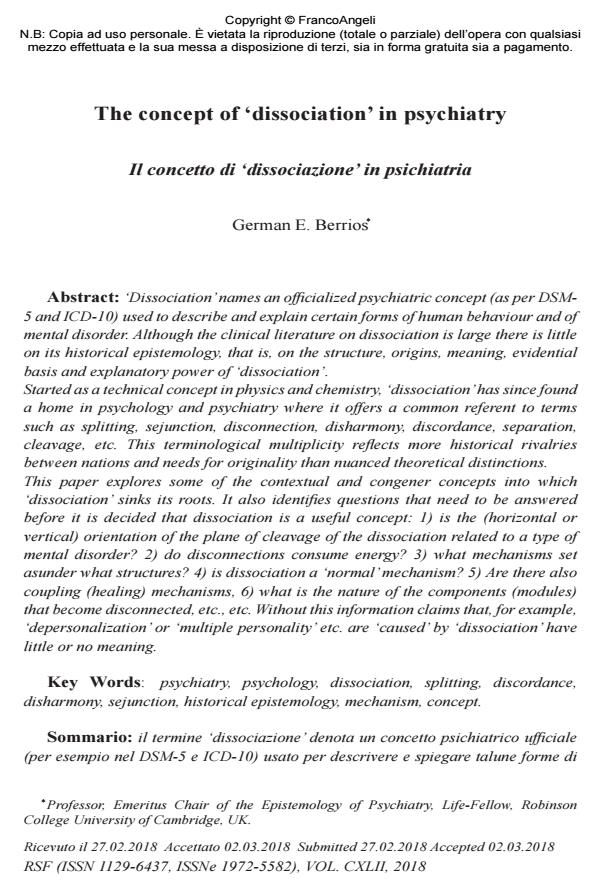The concept of ‘dissociation’ in psychiatry
Titolo Rivista RIVISTA SPERIMENTALE DI FRENIATRIA
Autori/Curatori German E. Berrios
Anno di pubblicazione 2018 Fascicolo 2018/1
Lingua Inglese Numero pagine 22 P. 29-50 Dimensione file 1763 KB
DOI 10.3280/RSF2018-001003
Il DOI è il codice a barre della proprietà intellettuale: per saperne di più
clicca qui
Qui sotto puoi vedere in anteprima la prima pagina di questo articolo.
Se questo articolo ti interessa, lo puoi acquistare (e scaricare in formato pdf) seguendo le facili indicazioni per acquistare il download credit. Acquista Download Credits per scaricare questo Articolo in formato PDF

FrancoAngeli è membro della Publishers International Linking Association, Inc (PILA)associazione indipendente e non profit per facilitare (attraverso i servizi tecnologici implementati da CrossRef.org) l’accesso degli studiosi ai contenuti digitali nelle pubblicazioni professionali e scientifiche
‘Dissociation’ names an officialized psychiatric concept (as per DSM-5 and ICD-10) used to describe and explain certain forms of human behaviour and of mental disorder. Although the clinical literature on dissociation is large there is little on its historical epistemology, that is, on the structure, origins, meaning, evidential basis and explanatory power of ‘dissociation’. Started as a technical concept in physics and chemistry, ‘dissociation’ has since found a home in psychology and psychiatry where it offers a common referent to terms such as splitting, sejunction, disconnection, disharmony, discordance, separation, cleavage, etc. This terminological multiplicity reflects more historical rivalries between nations and needs for originality than nuanced theoretical distinctions. This paper explores some of the contextual and congener concepts into which ‘dissociation’ sinks its roots. It also identifies questions that need to be answered before it is decided that dissociation is a useful concept: 1) is the (horizontal or vertical) orientation of the plane of cleavage of the dissociation related to a type of mental disorder? 2) do disconnections consume energy? 3) what mechanisms set asunder what structures? 4) is dissociation a ‘normal’ mechanism? 5) Are there also coupling (healing) mechanisms, 6) what is the nature of the components (modules) that become disconnected, etc., etc. Without this information claims that, for example, ‘depersonalization’ or ‘multiple personality’ etc. are ‘caused’ by ‘dissociation’ have little or no meaning.
Il termine ‘dissociazione’ denota un concetto psichiatrico ufficiale (per esempio nel DSM-5 e ICD-10) usato per descrivere e spiegare talune forme di comportamento umano e di disturbo mentale. Sebbene la letteratura clinica sulla dissociazione sia vasta, si trova poco materiale sulla sua epistemologia storica, cioè sulla struttura, origini, significato, evidenze e potere esplicativo della ‘dissociazione’. Originatosi come concetto tecnico in fisica e chimica, la ‘dissociazione’ ha da allora trovato casa in psicologia e psichiatria dove offre un referente comune a termini come scissione, disgiunzione, disconnessione, disarmonia, discordanza, separazione, clivaggio, ecc. Questa molteplicità terminologica è più il riflesso di rivalità storiche tra nazioni e del bisogno di originalità che di sfumate differenze teoriche. Questo articolo esplora alcuni dei concetti contestuali e congeneri in cui la ‘dissociazione’ affonda le sue radici. Inoltre individua domande a cui si deve dare risposta prima di giungere alla conclusione che la dissociazione sia un concetto utile: 1) l’orientamento (orizzontale o verticale) del piano di scissione della dissociazione è correlato ad un tipo di disturbo mentale? 2) le disconnessioni consumano energia? 3) quali meccanismi compartimentano quali strutture? 4) la dissociazione è un meccanismo ‘normale’? 5) esistono anche dei meccanismi (di guarigione) di associazione? 6) quale è la natura dei componenti (moduli) che si disconnettono, e così via. Senza queste informazioni l’affermazione che, per esempio, la ‘depersonalizzazione’ o ‘la personalità multipla’ siano ‘causate’ dalla ‘dissociazione’ ha poco o nullo significato.
Parole chiave:Psichiatria, psicologia, dissociazione, splitting, discordanza, disarmonia, disgiunzione, epistemologia storica, meccanismo, concetto
German E. Berrios, The concept of ‘dissociation’ in psychiatry in "RIVISTA SPERIMENTALE DI FRENIATRIA" 1/2018, pp 29-50, DOI: 10.3280/RSF2018-001003